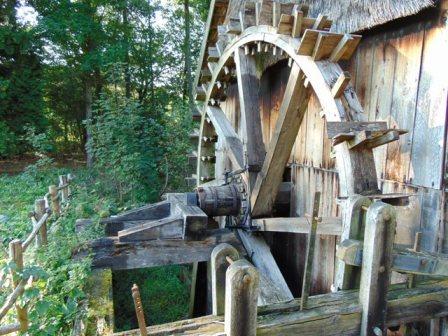Mills can be classified according to the depth of the water wheel in relation to the water level
overshot mills (water usually runs through a dam and a aqueduct on top of the wheel)
breastshot mills (wheel in the water or flow in the middle, on shaft height),
undershot mills (also floating, water runs under the wheel, and the bottom moves with the flow),
and
turbine mills (where the blades are completely under water).
 If in an overshot mill, the water lets rotate the wheel along in the flow direction an efficiency of 70% is given. The water then drops passed 12 hours, e.g. 11 hours at the wheel. (12 hours is the top, like on a clock face.)
If in an overshot mill, the water lets rotate the wheel along in the flow direction an efficiency of 70% is given. The water then drops passed 12 hours, e.g. 11 hours at the wheel. (12 hours is the top, like on a clock face.)
When the water hits the wheel at 01 o'clock the mill turns in the other direction (pitch back), and an efficiency of 90% was achieved.
A breastshot mill gets 50, and the oldest and easier to build undershot mills are using only 20% of the energy of the water.
The angle at which the buckets or shells are made at the wheel is found to be from experience optimally at 114°. The weight of the water in the shells has to rotate the wheel.
Sometimes, the impeller is used for the lifting of water.
Nowadays in the basin of the Meuse are still 450 mills. Between 1500 and 1800 there were 2,250 à 4,500 of them.
The implantation site for a mill was sometimes pretty ingenious selected or manipulated, so there was at the flowing water also a pond as a buffer (found or made). Which could be used as a reserve battery if there was less flow in drier periods. Clever is not it?
With sufficient decay can also a small mill with some jets be put into motion.
http://www.lowtechmagazine.be/2013/08/waterkracht-oude-stijl-moderne-materialen.html
“A mill cannot grind with water that is past” (American proverb)
